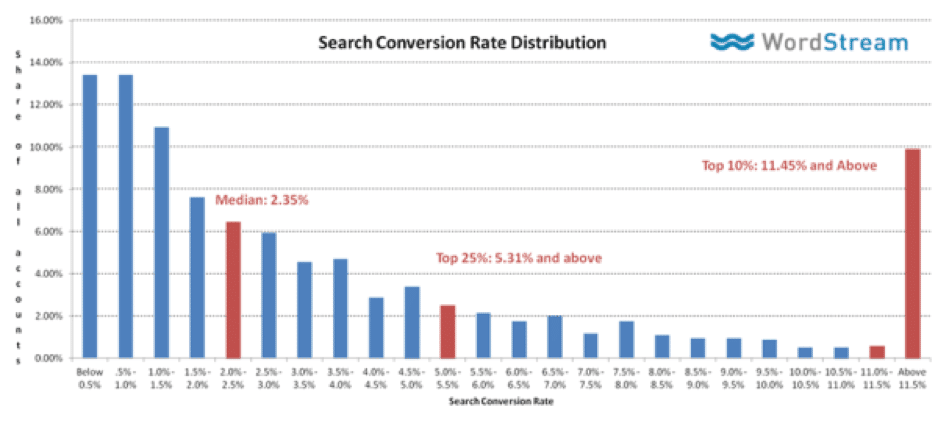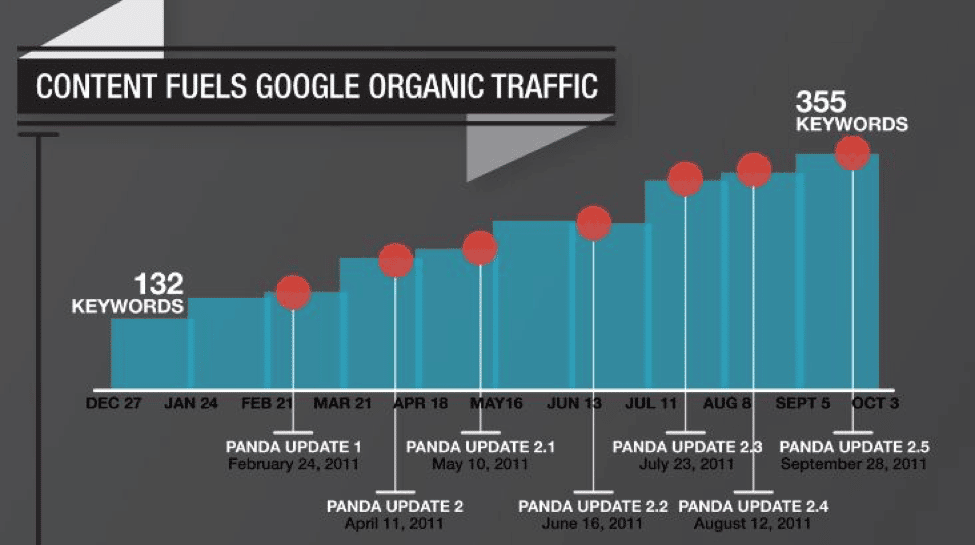If your traffic isn’t interested now and never will be, it will never convert, however much you optimize your site. And you don’t really know your conversion rate if you don’t know how convertible your traffic is.
Conversion rate optimization is there to increase the number of website visitors who become customers. It aims to look at the process by which people ‘convert’ – basically, do the things you want them to do.
If I come to your website, then click on a link and sign up for your newsletter in exchange for a report or a white paper, that’s a conversion. I haven’t become a customer but I’ve taken a step in the right direction.
Now you can send me nurturing emails, convince me with content and tempt me with offers such as a free trial, increasing the likelihood that I’ll take action further down the funnel and eventually start paying you for your product/service.
Working to increase conversion rates lets you extract more value from the traffic your site gets: after you paid out for content, search optimization, and PPC, you want to get everything you can from it. How much of a difference can CRO make?
What CRO Can Do
The average across the industry for landing pages – first-contact pages specifically targeted at segments of traffic and designed to produce conversions, often in the form of lead capture – is 2.35%.

Around 50% of leads are actually qualified but not ready to buy; 25% are immediate sales opportunities. Of these, about 8% to 20% become sales.
Let’s plug some numbers into this and see what we get.
Say you have 1000 website visitors, and your product is worth $100. With a conversion rate of 2.35%, you have 23.5 leads (and probably 2.4 kids too).
Of those 23.5 leads, 25% – about 4 leads – are immediate sales opportunities. 50% will eventually become sales ready. Of these 12 people, let’s say 17% will buy. That’s 2 sales. Bingo – $200.
Now, let’s change just one number: conversion rate. We’ll make your conversion rate 3.35% instead of 2.35%.
Now, of your 1000 visitors, you have 33.5 leads. 75% have the potential to buy, now or in the future, at the rate of 17%. Same figures as before. The only difference is, now we’re dealing with 24 potential sales instead of 12. That’s 4 sales and $400 in revenue.
In other words, a 100% increase in the numbers that really count. From just a 1% change in conversion rate.
Conversion rate optimization takes traffic and makes customers. If you have any kind of decent traffic numbers, you need CRO. But just because it’s a great tool, doesn’t mean it’s great for everything.
…And What It Can’t
Because the trouble with CRO is, it gets applied uncritically. Too many folks think it’s a catch-all solution that applies to their problems – all their problems. Before you know it people are A/B testing different colored CTAs six ways to Sunday without first answering more fundamental questions.
Questions like: is my traffic relevant at all? If your traffic isn’t relevant, it will never convert.
That means if you haven’t assessed your traffic, you don’t know how effective your CRO efforts are, or what your real conversion rate is, or what your next step should be.
A lot of the traffic you generate likely can’t be ‘optimized’ for anything because it consists of people who are basically uninterested in your product and your business and will never convert – no matter the color of your buttons or the persuasiveness of your copy.
The result? You wind up ‘CROing weeds’ – wasting time and effort trying to convert traffic as if every visitor was a potential customer. In fact, much of your hard-won traffic is likely worthless. And if you’re doing all the standard lead gen best practice, your leads are probably also ‘weedy.’
The Weeds in Your Traffic
Disruptive Advertising CEO Jacob Baadsgard says he’s conducted over 1000 keywords audits and the results were surprising. Turns out, most of the traffic to most people’s sites is weeds.
61% of AdWords budgets are spent on keywords that never convert. And on average, 100% of the conversions in an AdWords campaign will come from 12% of the keywords. That means 88% of the campaign is wasted. In the marketing channel where we have the most control and the most information, more than three-quarters of what we do is a total waste of time!
That’s one reason why so many people have such poor conversion rates. The sites that have conversion rates up in the 10% range are converting more traffic. But equally importantly, they’re generating more traffic that’s capable of being converted.
Stop thinking of your traffic as one stream of visitors. Your traffic consists of two groups: convertibles and non-convertibles.
Say your traffic is 25% convertible and 75% non-convertible and you’re converting 23.5 of every 1000 visitors. That looks like a conversion rate of 2.35%. But in fact, 75% of visitors are never, ever going to convert. You only have 250 convertible visitors, of whom you’re converting nearly one in 10. You have a conversion rate of 9.4% and a lot of junk traffic.
If this is you, you don’t have a CRO problem so much as a traffic problem: before you get all multivariate testing crazy on your landing pages, look again at search and content and try to get better traffic.
The Traffic Disconnect
“Marketers learn about SEO tactics and actually do a good job applying them.Before they know it, their site’s traffic has risen to 3,000 visits a month, then to 10,000, then to 20,000. Along with growing their traffic numbers, these marketers also build up their email lists from this traffic…”
It’s Neil Patel, explaining how the mismatch between traffic and actual interest comes about. Marketers get crazy about building traffic and signups.
“And then,” Neil goes on, “they launch a product and get horrendous conversion rates.”
The problem comes about when you attract traffic that’s interested in your niche, but not interested in the product you’re selling.
We need to make sure our traffic is coming from people who are actually interested in what we sell.
Optimizing Traffic From Search
Optimizing search traffic starts with identifying which search terms are driving engagement with your product/service, rather than your niche or space (more generally).
For instance, if you sell courses that teach people how to code for games, you might be scoring traffic from people who are interested in games more generally. If you’re using headlines that are optimized to pull in maximum traffic, you might be referring to popular games to ride on their popularity.
Your analytics data won’t always tell you there’s a problem if you just look at top-of-funnel metrics like bounce rate and page views because some of those people will have a genuine interest in how the games they love are put together.
You’re serving that audience pretty well. But they’re never going to be interested in learning to code.
Go back through your search terms and weed out anything that doesn’t describe or refer to your product. That means your keyword lists for organic search, and your PPC campaign keywords if you’re running any.
Search terms that would be great for a site that teaches you to code for games:
- Learn to code
- Code games
- Games programming
- Learn games programming
… and search terms that wouldn’t:
- coding websites
- game codes
- computer programming games
Use search terms that are too vaguely associated with your product, or that speak to your space but not your product, and you’re going to get more traffic that isn’t interested in buying from you.
Search terms come in three flavors: navigational, informational or educational and transactional or commercial.
Navigational search terms: entered with the intention of navigating to a particular page or site. Ever typed ‘Youtube’ into Google? That’s a navigational search.
Informational: Search terms entered by people looking for broad information about a topic or niche. Broad topics mean you’re competing against everyone; vague intentions mean you don’t know what your visitors are really interested in.
Transactional: search terms entered by people who are planning on making a purchase or solving a problem right now.
In paid search, you should have data on conversions per search term in your quarterly records. Expect to find a lot of junk, and be willing to be ruthless with it. You’re going to find at least a few terms that never convert and most likely never will. You can safely dump these. Check the results – but if traffic falls and conversions don’t, you know the reason why.
If that leaves you with a tight budget, you can reallocate it to search terms that do generate conversions, knowing that you’re reinforcing success.
Optimizing Traffic From Content
Content is a major source of traffic. The more heavily Google invests efforts in semantic search, the more effective it is:

(Source)
Keywording alone is a less effective way to generate the right traffic. Instead, Google is increasingly concentrating on delivering search results that are appropriate to searchers’ intent rather than search terms, using increasingly sophisticated machine learning to make semantic matches.
None of that means keywording doesn’t work. It just means we have to go about it differently, and that’s actually good news for those of us looking to tighten up our traffic because it forces us to focus on audience intent. Rather than creating a post for every possible iteration of ‘learn to code games’ or something similar, we can create posts that speak to our audience personas directly and know that Google will do a pretty good job of serving them that content.
But, notice I said ‘pretty good.’ As in, ‘not awesome.’ As in, ‘you should totally still do keywording.’
Within content that’s optimized for semantic search, we can still make hay with intelligent keywording. “My recommendation is to combine these two things,” says Rand Fishkin. “In a smart combination of these techniques, we can get great results on both sides of the aisle.”
The strategy Rand suggests is to group keywords (remember, audience-appropriate transactional keywords) and group them by search intent. Ideally, what you’ll end up with is more than keyword matches. Instead, says Rand, you’ll have “concept and topic matches, but taken to the keyword level so that we actually know things like the volume, the difficulty, the click-through rate opportunity for these, the importance that they may have or the conversion rate that we think they’re going to have.”
To see which of your content is already drawing highly relevant traffic, you can get a quick and dirty view through Google Analytics: check out the New vs Returning traffic report. People who are returning regularly are very unlikely to be getting lost over and over again; they know what you’re about, they like it and they keep coming back. (The more your content is tailored to serve your ideal audience the more effective this is.)
Final Thoughts
CRO unquestionably works, but it can only work on relevant traffic. By getting your traffic dialed in as soon as possible, you’re saving money on content marketing, PPC, and SEO, and making sure that the traffic you get is relevant to your business and your product/service. That way, when you come around to optimizing your site for conversions, you should really see the needle move.






